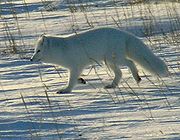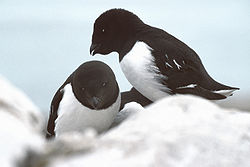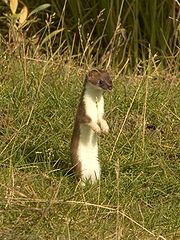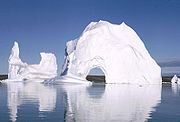
Scoresby Sund
Encyclopedia
Scoresby Sund is an inlet
system of the Greenland Sea
on the eastern coast of Greenland
. It has a tree-like structure, with a main body approximately 110 km (68.4 mi) long that branches into a system of fjord
s covering an area of about 38000 km² (14,671.9 sq mi). The longest of these extends 340–350 km in from the coastline. The depth is 400–600 m in the main body, but this increases to up to 1450 m (4,757.2 ft) in the fjords. It is the largest and longest fjord system in the world.
The name honors the English explorer William Scoresby
, who in 1822 mapped the fjord area in great detail. Numerous islands are present. The largest, Milne Land
, has an area of 3,913 km² and is located in the middle of the inlet. On the northern side of the mouth stands Ittoqqortoormiit
, the only permanent settlement in the region, with a population of 469 (in 2010).
 The mouth is 29 km wide between the Kangikajik (Kap Brewster, 70°09'N) and Uunarteq (Kap Tobin 70°24'N). Its southern part is a steep, 1000–2000 m tall wall of basalt
The mouth is 29 km wide between the Kangikajik (Kap Brewster, 70°09'N) and Uunarteq (Kap Tobin 70°24'N). Its southern part is a steep, 1000–2000 m tall wall of basalt
, and the northern side is lower and more rounded. The mouth extends for about 110 km to the west, slightly turns north, widens, and forms a basin called Hall Bredning. From there, the inlet splits into several branches including the Nordwestfjord, Øfjord (which splits into the Rypefjord and Harefjord), Røde Fjord, Gasefjord and Fønfjord. Between the Øfjord and Fønfjord lies the largest island of the system, Milne Land. The land surrounding the fjord is mostly mountainous, with steeply rising edges.
, with the long cold winter and severe storms. The temperatures of January–March vary between –22.5 and –8.4 °C with the average between –15 and –18 °C over the period 1971–1981. The mean summer temperatures are below 5 °C. Precipitation is low, at about 30 mm/month. Tide
s are semidiurnal, with the amplitude of 1.3 meters.
s not freezing even in winter, protection from the winds by the high relief, and relatively fertile land. The land animals include muskox, Arctic Fox
, stoat
, Mountain Hare
and lemming
. Reindeer
and Arctic Wolf
used to live in the area, but disappeared around the early 20th century.
Birds are represented by Barnacle Goose
, pink-footed goose
, snow goose
, whooper swan
, King Eider
, Common Eider
, long-tailed duck
, Brunnich's guillemot
, black guillemot
, little auk
, puffin
, fulmar
, herring gull, glaucous gull
, Great Black-backed Gull
, kittiwake
, Arctic tern
, red-throated diver
, great Northern Diver
, red-breasted merganser
, ptarmigan, raven, snowy owl
, Greenlandic gyrfalcon
, etc. Most of them are migrating species and form large colonies which may contain up to millions of individuals (for little auk).
Fishes of the area include Arctic char
, Greenland halibut
, polar cod
, cuttlefish
, wolf fish, sea scorpion
and Greenland shark
. Aquatic mammals are dominated by seals (ringed
, hooded
, harbor, bearded
and harp seal
) which feed on fish in winter (mostly polar cod
) and crustaceans in summer. Larger species include Atlantic walrus
, narwhal
and sometimes beluga whale. Atlantic walrus feeds on mussel
s, fish and ringed seals that urges ringed seals to disappear from the area when walruses stay there for prolonged periods. Narwhals consume polar cod, Greenland halibut, cuttlefish and pelegaec crustaceans.
Inlet
An inlet is a narrow body of water between islands or leading inland from a larger body of water, often leading to an enclosed body of water, such as a sound, bay, lagoon or marsh. In sea coasts an inlet usually refers to the actual connection between a bay and the ocean and is often called an...
system of the Greenland Sea
Greenland Sea
The Greenland Sea is a body of water that borders Greenland to the west, the Svalbard archipelago to the east, Fram Strait and the Arctic Ocean to the north, and the Norwegian Sea and Iceland to the south. The Greenland Sea is often defined as part of the Arctic Ocean, sometimes as part of the...
on the eastern coast of Greenland
Greenland
Greenland is an autonomous country within the Kingdom of Denmark, located between the Arctic and Atlantic Oceans, east of the Canadian Arctic Archipelago. Though physiographically a part of the continent of North America, Greenland has been politically and culturally associated with Europe for...
. It has a tree-like structure, with a main body approximately 110 km (68.4 mi) long that branches into a system of fjord
Fjord
Geologically, a fjord is a long, narrow inlet with steep sides or cliffs, created in a valley carved by glacial activity.-Formation:A fjord is formed when a glacier cuts a U-shaped valley by abrasion of the surrounding bedrock. Glacial melting is accompanied by rebound of Earth's crust as the ice...
s covering an area of about 38000 km² (14,671.9 sq mi). The longest of these extends 340–350 km in from the coastline. The depth is 400–600 m in the main body, but this increases to up to 1450 m (4,757.2 ft) in the fjords. It is the largest and longest fjord system in the world.
The name honors the English explorer William Scoresby
William Scoresby
William Scoresby , was an English Arctic explorer, scientist and clergyman.-Early years:Scoresby was born in the village of Cropton near Pickering 26 miles south of Whitby in Yorkshire. His father, William Scoresby , made a fortune in the Arctic whale fishery...
, who in 1822 mapped the fjord area in great detail. Numerous islands are present. The largest, Milne Land
Milne Land
Milne Land is a large island in eastern Greenland. It is the third largest island of Greenland, after the main island of Greenland and Disko Island. It is named after British admiral David Milne. It is 113 km long from Moræne Pynt in the southwest to Bregnepynt in the northeast, and up to 45 km...
, has an area of 3,913 km² and is located in the middle of the inlet. On the northern side of the mouth stands Ittoqqortoormiit
Ittoqqortoormiit
Ittoqqortoormiit is a settlement in the Sermersooq municipality in eastern Greenland. Its population is 469 as of 2010.The Danish name Scoresbysund derives from the name of the Arctic explorer and whaler William Scoresby, who was the first to map the area in 1822. The Greenlandic name...
, the only permanent settlement in the region, with a population of 469 (in 2010).
Geography

Basalt
Basalt is a common extrusive volcanic rock. It is usually grey to black and fine-grained due to rapid cooling of lava at the surface of a planet. It may be porphyritic containing larger crystals in a fine matrix, or vesicular, or frothy scoria. Unweathered basalt is black or grey...
, and the northern side is lower and more rounded. The mouth extends for about 110 km to the west, slightly turns north, widens, and forms a basin called Hall Bredning. From there, the inlet splits into several branches including the Nordwestfjord, Øfjord (which splits into the Rypefjord and Harefjord), Røde Fjord, Gasefjord and Fønfjord. Between the Øfjord and Fønfjord lies the largest island of the system, Milne Land. The land surrounding the fjord is mostly mountainous, with steeply rising edges.
Climate
The climate is ArcticClimate of the Arctic
The climate of the Arctic is characterized by long, cold winters and short, cool summers. There is a large amount of variability in climate across the Arctic, but all regions experience extremes of solar radiation in both summer and winter...
, with the long cold winter and severe storms. The temperatures of January–March vary between –22.5 and –8.4 °C with the average between –15 and –18 °C over the period 1971–1981. The mean summer temperatures are below 5 °C. Precipitation is low, at about 30 mm/month. Tide
Tide
Tides are the rise and fall of sea levels caused by the combined effects of the gravitational forces exerted by the moon and the sun and the rotation of the Earth....
s are semidiurnal, with the amplitude of 1.3 meters.
Fauna
The fauna of the region is unusually rich for Greenland. This is because of several factors, such as availability of open water in the mouth, with polynyaPolynya
A polynya or polynia is an area of open water surrounded by sea ice. It is now used as geographical term for an area of unfrozen sea within the ice pack. It is a loanword from , , which means a natural ice hole, and was adopted in the 19th century by polar explorers to describe navigable...
s not freezing even in winter, protection from the winds by the high relief, and relatively fertile land. The land animals include muskox, Arctic Fox
Arctic fox
The arctic fox , also known as the white fox, polar fox or snow fox, is a small fox native to Arctic regions of the Northern Hemisphere and is common throughout the Arctic tundra biome. The Greek word alopex, means a fox and Vulpes is the Latin version...
, stoat
Stoat
The stoat , also known as the ermine or short-tailed weasel, is a species of Mustelid native to Eurasia and North America, distinguished from the least weasel by its larger size and longer tail with a prominent black tip...
, Mountain Hare
Mountain Hare
The Mountain Hare , also known as Blue Hare, Tundra Hare, Variable Hare, White Hare, Alpine Hare and Irish Hare, is a hare, which is largely adapted to polar and mountainous habitats. It is distributed from Fennoscandia to eastern Siberia; in addition there are isolated populations in the Alps,...
and lemming
Lemming
Lemmings are small rodents, usually found in or near the Arctic, in tundra biomes. They are subniveal animals, and together with voles and muskrats, they make up the subfamily Arvicolinae , which forms part of the largest mammal radiation by far, the superfamily Muroidea, which also includes rats,...
. Reindeer
Reindeer
The reindeer , also known as the caribou in North America, is a deer from the Arctic and Subarctic, including both resident and migratory populations. While overall widespread and numerous, some of its subspecies are rare and one has already gone extinct.Reindeer vary considerably in color and size...
and Arctic Wolf
Arctic Wolf
The Arctic Wolf , also called Polar Wolf or White Wolf, is a subspecies of the Gray Wolf, a mammal of the family Canidae. Arctic Wolves inhabit the Canadian Arctic, Alaska and the northern parts of Greenland....
used to live in the area, but disappeared around the early 20th century.
Birds are represented by Barnacle Goose
Barnacle Goose
The Barnacle Goose belongs to the genus Branta of black geese, which contains species with largely black plumage, distinguishing them from the grey Anser species...
, pink-footed goose
Pink-footed Goose
The Pink-footed Goose is a goose which breeds in eastern Greenland, Iceland and Svalbard. It is migratory, wintering in northwest Europe, especially Great Britain, the Netherlands, and western Denmark...
, snow goose
Snow Goose
The Snow Goose , also known as the Blue Goose, is a North American species of goose. Its name derives from the typically white plumage. The genus of this bird is disputed...
, whooper swan
Whooper Swan
The Whooper Swan , Cygnus cygnus, is a large Northern Hemisphere swan. It is the Eurasian counterpart of the North American Trumpeter Swan. An old name for the Whooper Swan is Elk; it is so called in Francis Willughby and John Ray's Ornithology of 1676.-Description:The Whooper Swan is similar in...
, King Eider
King Eider
The King Eider is a large sea duck that breeds along northern hemisphere Arctic coasts of northeast Europe, North America and Asia. The birds spend most of the year in coastal marine ecosystems at high latitudes, and migrate to Arctic tundra to breed in June and July...
, Common Eider
Common Eider
The Common Eider, Somateria mollissima, is a large sea-duck that is distributed over the northern coasts of Europe, North America and eastern Siberia. It breeds in Arctic and some northern temperate regions, but winters somewhat farther south in temperate zones, when it can form large flocks on...
, long-tailed duck
Long-tailed Duck
The Long-tailed Duck or Oldsquaw is a medium-sized sea duck. It is the only living member of its genus, Clangula; this was formerly used for the goldeneyes, with the Long-tailed Duck being placed in Harelda...
, Brunnich's guillemot
Brünnich's Guillemot
The Thick-billed Murre or Brünnich's Guillemot is a bird in the auk family . This bird is named after the Danish zoologist Morten Thrane Brünnich...
, black guillemot
Black Guillemot
The Black Guillemot or Tystie is a medium-sized alcid.Adult birds have black bodies with a white wing patch, a thin dark bill, and red legs and feet. They show white wing linings in flight. In winter, the upperparts are pale grey and the underparts are white. The wings remain black with the large...
, little auk
Little Auk
The Little Auk, or Dovekie , is a small auk, the only member of the genus Alle. It breeds on islands in the high Arctic. There are two subspecies: A. a. alle breeds in Greenland, Iceland, Novaya Zemlya and Spitsbergen, and A. a...
, puffin
Puffin
Puffins are any of three small species of auk in the bird genus Fratercula with a brightly coloured beak during the breeding season. These are pelagic seabirds that feed primarily by diving in the water. They breed in large colonies on coastal cliffs or offshore islands, nesting in crevices among...
, fulmar
Fulmar
Fulmars are seabirds of the family Procellariidae. The family consists of two extant species and two that are extinct.-Taxonomy:As members of Procellaridae and then the order Procellariiformes, they share certain traits. First, they have nasal passages that attach to the upper bill called...
, herring gull, glaucous gull
Glaucous Gull
The Glaucous Gull is a large gull which breeds in the Arctic regions of the northern hemisphere and the Atlantic coasts of Europe. It is migratory, wintering from in the North Atlantic and North Pacific oceans as far south as the British Isles and northernmost states of the USA, also on the Great...
, Great Black-backed Gull
Great Black-backed Gull
The Great Black-backed Gull is the largest gull in the world, which breeds on the European and North American coasts and islands of the North Atlantic...
, kittiwake
Kittiwake
The kittiwakes are two closely related seabird species in the gull family Laridae, the Black-legged Kittiwake and the Red-legged Kittiwake . The epithets "Black-legged" and "Red-legged" are used to distinguish the two species in North America, but in Europe, where R...
, Arctic tern
Arctic Tern
The Arctic Tern is a seabird of the tern family Sternidae. This bird has a circumpolar breeding distribution covering the Arctic and sub-Arctic regions of Europe, Asia, and North America...
, red-throated diver
Red-throated Diver
The Red-throated Loon or Red-throated Diver is a migratory aquatic bird found in the northern hemisphere. It breeds primarily in Arctic regions, and winters in northern coastal waters. It is the most widely distributed member of the loon or diver family. Ranging from in length, the Red-throated...
, great Northern Diver
Great Northern Diver
The Great Northern Loon, Great Northern Diver, or Common Loon , is a large member of the loon, or diver, family of birds...
, red-breasted merganser
Red-breasted Merganser
The Red-breasted Merganser is a diving duck.-Taxonomy:The Red-breasted Merganser was one of the many species originally described by Linnaeus in his 18th-century work, Systema Naturae.-Description:...
, ptarmigan, raven, snowy owl
Snowy Owl
The Snowy Owl is a large owl of the typical owl family Strigidae. The Snowy Owl was first classified in 1758 by Carolus Linnaeus, the Swedish naturalist who developed binomial nomenclature to classify and organize plants and animals. The bird is also known in North America as the Arctic Owl, Great...
, Greenlandic gyrfalcon
Gyrfalcon
The Gyrfalcon — Falco rusticolus — is the largest of the falcon species. The Gyrfalcon breeds on Arctic coasts and the islands of North America, Europe, and Asia. It is mainly resident there also, but some Gyrfalcons disperse more widely after the breeding season, or in winter.Individual vagrancy...
, etc. Most of them are migrating species and form large colonies which may contain up to millions of individuals (for little auk).
Fishes of the area include Arctic char
Arctic char
Arctic char or Arctic charr is both a freshwater and saltwater fish in the Salmonidae family, native to Arctic, sub-Arctic and alpine lakes and coastal waters. No other freshwater fish is found as far north. It is the only species of fish in Lake Hazen, on Ellesmere Island in the Canadian Arctic...
, Greenland halibut
Greenland halibut
The Greenland halibut or Greenland turbot belongs to the Pleuronectidae family , and is the only species of the genus Reinhardtius. It is a deepwater fish distributed from 200 to 1600 m but has been caught at depths more than...
, polar cod
Polar cod
The polar cod , also known as the Arctic cod, is a fish of the cod family Gadidae, related to the true cod . Note that there is another fish with the common name Arctic cod, Arctogadus glacialis....
, cuttlefish
Cuttlefish
Cuttlefish are marine animals of the order Sepiida. They belong to the class Cephalopoda . Despite their name, cuttlefish are not fish but molluscs....
, wolf fish, sea scorpion
Eurypterid
Eurypterids are an extinct group of arthropods related to arachnids which include the largest known arthropods that ever lived. They are members of the extinct order Eurypterida ; which is the most diverse Paleozoic chelicerate order in terms of species...
and Greenland shark
Greenland shark
The Greenland shark, Somniosus microcephalus, also known as the sleeper shark, gurry shark, ground shark, grey shark, or by the Inuit languages name Eqalussuaq, is a large shark native to the waters of the North Atlantic Ocean around Greenland and Iceland. These sharks live farther north than any...
. Aquatic mammals are dominated by seals (ringed
Ringed Seal
The ringed seal , also known as the jar seal and as netsik or nattiq by the Inuit, is an earless seal inhabiting the Arctic and sub-Arctic regions...
, hooded
Hooded Seal
The hooded seal is an arctic pinniped found only in the central and western North Atlantic ranging from Svalbard in the east to the Gulf of St...
, harbor, bearded
Bearded Seal
The bearded seal , also called the square flipper seal, is a medium-sized pinniped that is found in and near to the Arctic Ocean. It gets its generic name from two Greek words that refer to its heavy jaw...
and harp seal
Harp Seal
The harp seal or saddleback seal is a species of earless seal native to the northernmost Atlantic Ocean and adjacent parts of the Arctic Ocean. It now belongs to the monotypic genus Pagophilus. Its scientific name, Pagophilus groenlandicus, means "ice-lover from Greenland", and its synonym, Phoca...
) which feed on fish in winter (mostly polar cod
Polar cod
The polar cod , also known as the Arctic cod, is a fish of the cod family Gadidae, related to the true cod . Note that there is another fish with the common name Arctic cod, Arctogadus glacialis....
) and crustaceans in summer. Larger species include Atlantic walrus
Walrus
The walrus is a large flippered marine mammal with a discontinuous circumpolar distribution in the Arctic Ocean and sub-Arctic seas of the Northern Hemisphere. The walrus is the only living species in the Odobenidae family and Odobenus genus. It is subdivided into three subspecies: the Atlantic...
, narwhal
Narwhal
The narwhal, Monodon monoceros, is a medium-sized toothed whale that lives year-round in the Arctic. One of two living species of whale in the Monodontidae family, along with the beluga whale, the narwhal males are distinguished by a characteristic long, straight, helical tusk extending from their...
and sometimes beluga whale. Atlantic walrus feeds on mussel
Mussel
The common name mussel is used for members of several families of clams or bivalvia mollusca, from saltwater and freshwater habitats. These groups have in common a shell whose outline is elongated and asymmetrical compared with other edible clams, which are often more or less rounded or oval.The...
s, fish and ringed seals that urges ringed seals to disappear from the area when walruses stay there for prolonged periods. Narwhals consume polar cod, Greenland halibut, cuttlefish and pelegaec crustaceans.
 |
 |
 |
||
| Muskox | Arctic Fox | Little auk | Atlantic puffin | stoat |
Landscapes
 |
 |
 |
| Scoresby Sund | Icebergs in July, 1970 | View of Ittoqqortoormiit Ittoqqortoormiit Ittoqqortoormiit is a settlement in the Sermersooq municipality in eastern Greenland. Its population is 469 as of 2010.The Danish name Scoresbysund derives from the name of the Arctic explorer and whaler William Scoresby, who was the first to map the area in 1822. The Greenlandic name... in summer |

